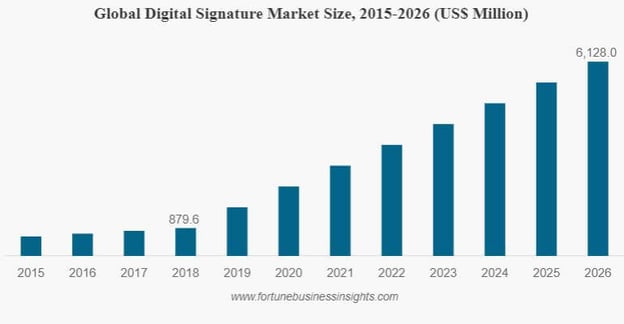The importance of electronic signature technology in the business process
In the current context of the COVID-19 pandemic and the challenges it poses for the workforce, many businesses have deployed remote working for the safety of their employees. This raises the issue of whether documents can be signed electronically to avoid meeting in person.
In this era of digital transformation, information at all levels can be captured, delivered, processed, and represented electronically. If a couple of decades ago, the concept of signing digital documents was hard to imagine, twenty years later, electronic signature technology has proven to be a great technological innovation and has become essential to workflow improvement.
An electronic signature, also known as e-signature, is defined as “any electronic proof that indicates acceptance of an agreement or record”. It is a legal way to get consent or approval on electronic documents by using a single-factor authorization with variables like passwords, unique PINs, and security numbers to verify identity. Proof of signing a document is achieved using an audit trail function embedded within each digital page. An e-signature can replace a handwritten signature in virtually any process.
According to Fortune Business Insights, the global digital signature market, valued at US$ 879.6 Mn in 2018, is projected to reach US$ 6,128.0 Mn by the end of 2026, exhibiting a CAGR of 28.77% during the forecast period (2019-2026).

How does E-signature technology work?
E-signature makes it possible for the traditional process – the handwritten signature – to become 100% online, remote and can be achieved through any digital device, as it composes a series of encrypted data attached in an electronic message with full integrity. This technology is based on different techniques for signing a document but below you can find out a few basic parts of the process common to most solutions.
The process consists of the identity verification of the signer and the subsequent signature registration and contractual acceptance. In the first part of the process, different methods are used such as biometric authentication, cards of coordinates, or one-time-password (OTP) to verify the identity of the signer. Further on, in the second part of the signing process, different types of cryptographic techniques are performed to ensure the security and subsequent inviolability of the time stamp, the document, and to join the signature to the identity of the signer.
Therefore, when a person signs a document electronically, the signature is created using the signer’s private key, which is always securely restored by the signer. This algorithm acts as a code, creating data matching the signed document and encrypting that data as an advanced electronic signature. When the document is sent via e-mail, the signer uses the private key to decrypt the signature code. If the values are equal, then the signature is valid.
Benefits of using electronic signature across software solutions
First and foremost, electronic documents save time, a most precious resource. There is no need to print out, scan, post document, wait for a client to sign it, and then send the document back. You can sign electronically the document in moments and send it back right away. Moreover, you can sign documents anywhere, on any device. In a few simple clicks, within seconds, you can add an electronic signature to a document using your tablet or mobile device.

Image source: rawpixel.com
Compared to the traditional document flow, using e-signatures is more cost-effective and increases productivity. You can save paper, printing, packaging, and shipping costs and the time you win back using electronic signature technology can make you more productive and allow you to focus on other important tasks. In this way, you also automate document flow and minimize repetitive tasks.
Also, electronic signature secures document flow and improves customer experience by reducing risks and errors while ensuring greater security and mobility.
Let’s take, for example, a situation when you may dispatch a document, wait for it to be delivered back to you, and receive it only to find some signatures missing. The e-signature solution not only eliminates these risks but also adds up to the documents’ security due to the strong encryption algorithms. A reliable electronic signature software gives you total control over your workflow and by using the audit trail feature you can track all changes made in the document.
How can an electronic signature feature help in the Onboarding process?
In the banking sector, the increased use of digital capabilities has had and continues to have a powerful impact on how customers expect to engage with the bank services. The onboarding journey is the customer’s first impression of how they will be able to interact with the bank once an account is opened. Thus, the banks have a big responsibility for providing a customer-friendly experience and ensuring a continuous onboarding process that can give the banks not only an edge over competitors but also enhance how existing customers can access new products and services.
Electronic Signature secured with OTP in a Digital Onboarding for Banking solution

Image source: medium.com
E-signature secured with the OTP feature and compliant with eIDAS European Regulation 910/2014 enables banks to provide a digital seal on the onboarding digital document generated for the customer.
After completing the onboarding flow online, the documents that the customer needs to sign are generated online and can be reviewed in real-time or downloaded for later. Documents are also sent to you by email and can be signed at a later time when you use the link sent via email. To receive the certificate, you need to provide your consent, as required by the Certification Authority related to terms and conditions and the GDPR.
You will receive via SMS an OTP associated with a unique transaction ID shown in the signing screen, valid for up to 60 minutes, which you use to sign the generated documents that will be also automatically signed by the Bank, saved in the management system documents and shared to you by email.
How can Encora help you?
Understanding where you are in your digital transformation process is the starting point of the journey. From there, we can help you deliver the best user experience in the era of digital transformation in banking and finance.
We can build tailored electronic signature solutions for customer onboarding that balance ease of use with the highest levels of security and compliance. Our omnichannel software solutions enable digital onboarding and KYC workflows in compliance with biometric authentication, electronic signature, data protection, and AML regulations.
Resources:
https://www.fortunebusinessinsights.com/industry-reports/digital-signature-market-100356
https://eur-lex.europa.eu/legal-content/EN/TXT/?uri=uriserv%3AOJ.L_.2014.257.01.0073.01.ENG
https://www.forbes.com/



